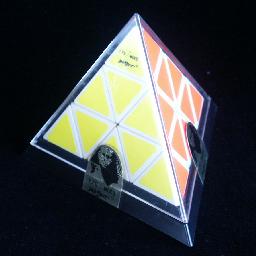
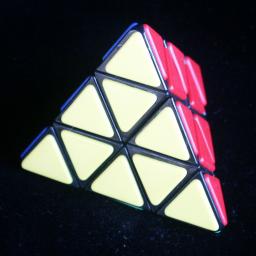
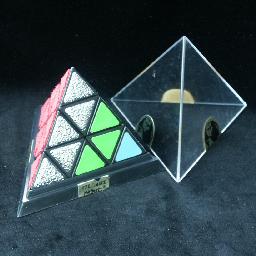
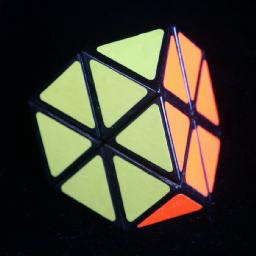
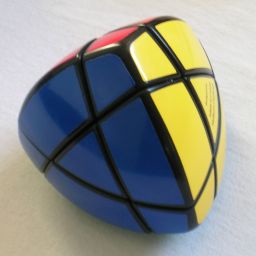
|
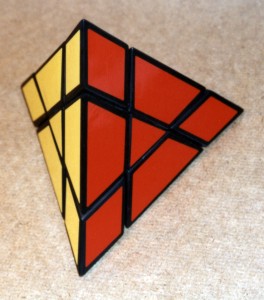 Picture kindly supplied by Hendrik Haak |





|
 Picture kindly supplied by Hendrik Haak |
The standard Pyraminx is a regular tetrahedron, of which each triangular face is divided into 9 identical smaller triangles, three to a side. A move consist of rotating a sub-tetrahedron around a vertex; either just a tip or a larger tetrahedron (two triangles to a side). Each face has one colour, so the edge pieces have two colours, while the tips and the adjacent vertex pieces have three colours each.
The Pyraminx was invented by Uwe Mèffert in about 1971, but he only started producing it when the Cube Craze hit, and after he had carefully secured patents in most relevant countries, in particular Taiwan and Korea which haven't signed international patent treaties. A European Patent was granted on 30 December 1981, EP 42,695.
There several similar puzzles. The Tetraminx is a snub tetrahedron, which is the same as a Pyraminx but without the tips, also produced by Mèffert (though the first ones were crude versions made by Rubin's Toy Co. from Canada). A similar puzzle not pictured here was produced in Taiwan, and has a more rounded shape, with circular faces (like a sphere with 4 caps cut off). The most interesting variation was invented independently, and is nowadays called the Halpern-Meier Pyramid. It is cut differently than the pyraminx; the sub-pyramids are larger so that each face has a centre piece. Mechanically, it is those faces which are fixed to the centre, whereas in the pyraminx it is the corners which are on axes. Uwe Meffert bought the patent rights to it. The recently released Jing Pyraminx is a rounded version of this puzzle.
If your browser supports JavaScript, then you can play the Pyraminx by clicking the link below:
There are 4 vertex pieces with 3 orientations, 6 edge pieces with 2 orientations giving a maximum of 6!·26·34 positions. This limit is not reached because:
This leaves 6!·24·34 = 933,120 positions.
If you include the trivial vertex tips then this has to be multiplied by a further 34=81. The Jing Pyraminx or Halpern-Meier pyramid instead has only 4 times as many positions.
This puzzle is closely related to the Skewb which also has four axes of rotation. The vertices and the face centres (if present) of the pyramid correspond to the corners of the Skewb, and the edges to the square faces of the Skewb. The Jing Pyraminx is in fact built on top of the skewb mechanism.
A computer search gives the following result (ignoring the tips):
| Depth | Pyraminx | H-M Pyramid / Jing Pyraminx |
|---|---|---|
| 0 | 1 | 1 |
| 1 | 8 | 8 |
| 2 | 48 | 48 |
| 3 | 288 | 288 |
| 4 | 1,728 | 1,728 |
| 5 | 9,896 | 10,128 |
| 6 | 51,808 | 57,780 |
| 7 | 220,111 | 305,483 |
| 8 | 480,467 | 1,239,266 |
| 9 | 166,276 | 1,879,631 |
| 10 | 2,457 | 237,320 |
| 11 | 32 | 778 |
| 12 | 21 | |
| Total | 933,120 | 3,732,480 |
| Avg Depth | 7.7955 | 8.5081 |
This shows that any pyraminx position can be solved in at most 11 moves (7.7955 on average), or 12 (8.5081 on average) for the Halpern-Meier Pyramid. In Sloane's On-Line Encyclopedia of Integer Sequences these are included as sequences A079744 and A079746. See the Ultimate Skewb page for tables of all the Skewb-related puzzles.
The number of positions is relatively small, so a computer can very quickly search through all positions to find the shortest possible solution for any given position. If your browser supports layers/styles, (i.e. Netscape 4+, Explorer 5+) then you can play a Javascript version which includes such a solver. It takes a moment to load because it has to prepare some pruning tables for the search algorithm of the solver.

Phase 1: Solve the tips
Phase 2: Solve the U vertices.
Phase 3: Solve the U edges.
Phase 4: Solve the D vertex piece.
Phase 5: Solve the D edges.
Phase 6: Solve face centres, for the Halpern-Meier pyramid or Jing Pyraminx only.